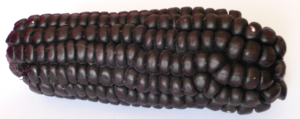الذرة الأرجوانية
Purple corn (إسپانية: maíz morado) or purple maize is group of flint maize varieties (Zea mays indurata) originating in South America, descended from a common ancestral variety termed "kʼculli" in Quechua.[1] It is most commonly grown in the Andes of Peru, Bolivia and Ecuador.
. . . . . . . . . . . . . . . . . . . . . . . . . . . . . . . . . . . . . . . . . . . . . . . . . . . . . . . . . . . . . . . . . . . . . . . . . . . . . . . . . . . . . . . . . . . . . . . . . . . . . . . . . . . . . . . . . . . . . . . . . . . . . . . . . . . . . . . . . . . . . . . . . . . . . . . . . . . . . . . . . . . . . . . .
الاستخدامات
Common in Peru, purple corn is used in chicha morada, a drink made by boiling ground purple corn kernels with pineapple, cinnamon, clove, and sugar, and in mazamorra, a type of pudding".[2] In Bolivia, purple corn "Kuli" is used in Api, a smoothie served hot.[3]
كيمياء اللون: anthocyanins
The pigment giving purple corn its vivid color derives from an exceptional content of a class of polyphenols called anthocyanins. Cyanidin 3-O-glucoside, also called chrysanthemin, is the major anthocyanin in purple corn kernels, comprising about 73% of all anthocyanins present.[4][5][6] Other anthocyanins identified are pelargonidin 3-O-β-D-glucoside, peonidin 3-O-β-D-glucoside, cyanidin 3-O-β-D-(6-malonyl-glucoside), pelargonidin 3-O-β-D-(6-malonyl-glucoside) and peonidin 3-O-β-D-(6-malonyl-glucoside).[4][5][6] Similar results for anthocyanin content were found from a variety of purple corn grown in China.[7]
Evaluating growing conditions for anthocyanin and total polyphenol content, one research group found that field location was an important determinant, whereas seedling density and soil potassium content were not.[8]
For ease of extractions, scientists have explored components of the purple corn plant for yield, such as kernels, cob and husk, possibly allowing use of a plentiful, non-edible residual biomass in cobs or husks. Husks of the purple corn plant contain about ten times higher content of anthocyanins than do kernels.[6]
انظر أيضاً
المراجع
- ^ Corral, Marta (6 November 2020). "Maíz morado: propiedades y beneficios del 'elixir' inca de la eterna juventud" [Purple corn: properties and benefits of the Inca 'elixir' of eternal youth]. El Español (in الإسبانية). Retrieved 30 January 2023.
- ^ Perich, Tatiana (14 September 2011). "De Arequipa a Mistura: Api, una mazamorra bebible hecha con maíz morado" [From Arequipa to Mistura: Api, a drinkable mazamorra made with purple corn]. El Comercio Peru (in الإسبانية). Retrieved 21 Feb 2013.
- ^ La diversidad del maíz nativo en Bolivia [The Diversity of Native Maize in Bolivia] (in الإسبانية). Ministerio de Medio Ambiente y Agua/ Organización de las Naciones Unidas para la Alimentación y la Agricultura - FAO. pp. 160 pp.
- ^ أ ب Aoki, Hiromitsu; Kuze, Noriko; Kato, Yoshiaki (April 2002). "Anthocyanins isolated from purple corn (Zea mays L.)" (PDF). Foods Food Ingred J Jpn. pp. 41–45. ISSN 0919-9772. OCLC 5171199616. S2CID 53073818. Archived from the original (PDF) on 29 October 2013. Retrieved 19 June 2014.
- ^ أ ب Cuevas Montilla, E; Hillebrand, S; Antezana, A; Winterhalter, P (2011). "Soluble and bound phenolic compounds in different Bolivian purple corn ( Zea mays L.) cultivars". Journal of Agricultural and Food Chemistry. 59 (13): 7068–74. doi:10.1021/jf201061x. PMID 21639140.
- ^ أ ب ت Li, C. Y.; Kim, H. W.; Won, S. R.; et al. (2008). "Corn husk as a potential source of anthocyanins". Journal of Agricultural and Food Chemistry. 56 (23): 11413–6. doi:10.1021/jf802201c. PMID 19007127.
- ^ Zhao, X; Corrales, M; Zhang, C; Hu, X; Ma, Y; Tauscher, B (2008). "Composition and thermal stability of anthocyanins from chinese purple corn ( Zea mays L.)". Journal of Agricultural and Food Chemistry. 56 (22): 10761–6. doi:10.1021/jf8025056. PMID 18950186.
- ^ Jing, P; Noriega, V; Schwartz, S. J.; Giusti, M. M. (2007). "Effects of growing conditions on purple corncob (Zea mays L.) anthocyanins". Journal of Agricultural and Food Chemistry. 55 (21): 8625–9. doi:10.1021/jf070755q. PMID 17880157.


